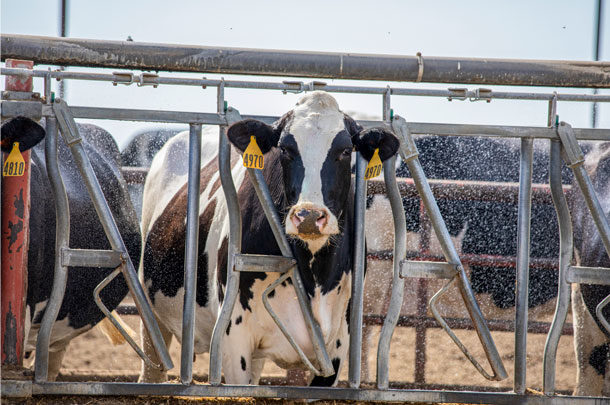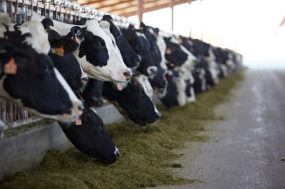Researchers in Arizona have indicated a THI threshold of 68 for dairy cows. The severity and length of time of index values over 68 has been shown to impact herd health and productivity.
A cow’s “comfort zone” is between 41ºF and 68ºF (5ºC and 20ºC). Cows start to experience mild to moderate heat stress at the THI threshold. They will start to reduce their dry matter intake (DMI) and begin to reduce milk production; at this point, we may see milk losses of 2.3 kilograms per cow per day.
When the THI climbs over 78, cows will be in moderate to severe stress with a possible milk loss of 3.6 kilograms per cow per day. Respiration rate increases to the point cows will begin to pant. While panting, cows lose saliva, sodium bicarbonate and water, which exacerbates the situation. Rumen pH may decrease due to less DMI and chewing, which then leads to rumen acidosis. Other effects of heat stress can lead to poor reproduction efficiency, milkfat depression, lameness, lowered immune response, mastitis and transition cow diseases.
Combat heat stress
There are several ways to combat heat stress, such as environmental and feeding strategies. If you have already made changes to your facility to cool animals down (such as shade, fans, misters, sprinklers and reducing the holding time at the parlour entrance and exit), the next step is to look at the diet:
1. Water: It’s essential to provide clean quality water to animals, especially during heat stress. It is also important to test the water consumed by cows. Consider monitoring water usage with a water meter. Since lactating dairy cows consume more water than any other nutrient – it is the greatest component of milk (approximately 87%) and manure (approximately 88%) – water is essential. Young calves, transition dairy cows (three weeks before through three weeks after parturition) and high-producing dairy cows have increased metabolic rates and greater water turnover, and therefore greater requirements for water compared to other groups of animals.
2. Forages: Lower-quality forages tend to stay in the rumen longer and result in more heat production, while high-quality forages are digested faster and result in less heat being produced.
3. Energy: This is a concern, as most energy is derived from the fermentation of forages within the rumen. Increasing the energy density might require greater amounts of concentrate or byproducts. But keep in mind that shifting the grain-to-forage ratio may increase the risk of not having enough rumen-effective fibre to optimize rumination. When the rumen mat formation is inadequate, there is less cud chewing activity and less saliva production, which can lead to a reduction in rumen pH and subacute rumen acidosis. Consider adding a good source of bypass fat in the diet which will help cows meet their energy requirement.
4. Protein: Consider increasing the protein density in the dairy ration by providing ruminal-digestible protein sources, slow-release nitrogen or bypass amino acids. During heat stress, a decline in DMI can decrease the amount of available protein and result in less microbial protein being available to the cow.
5. Minerals: Sweating aids in heat dissipation, where sodium, potassium and phosphorus are lost from the body. Some diet changes can be used to help with this nutrient loss. Buffers such as sodium bicarbonate should be increased to 225 to 340 grams per head per day. Consider dietary cation-anion difference (DCAD) balancing or ensure ration potassium is targeted at 1.5% to 1.7% of DMI. When environmental temperatures are above 86ºF (30ºC), make sure diets contain at least 90 to 115 grams of salt per cow per day.
Other minerals such as chromium can also aid in combating heat stress. Chromium is an essential micronutrient that potentiates insulin action at the cell level, thereby allowing tissues to take up more glucose from the bloodstream. Increased glucose availability and utilization has significant benefits for the dairy cow.
Chromium supplementation also minimizes the negative effects of the stress response by consistently decreasing serum cortisol during stressful periods for cattle. This mineral has been shown to increase insulin sensitivity and glucose utilization and improve DMI during heat stress to help maintain milk production.
The comfort of the cow during heat stress can be correlated to a productive and profitable cow. When facility improvements such as proper working fans, misters and shade are present, cows can still experience heat stress. Making dietary adjustments can help cows overcome the challenge of heat stress and thereby avoid decreased milk production and lowered fertility. ![]()
PHOTO: If you have already made changes to your facility to cool animals down (such as shade, fans, misters, sprinklers), the next step in minimizing heat stress is to look at the diet. Courtesy photo.
References omitted but are available upon request. Click here to email an editor.

-
Irene Brown-Crowder
- Technical Service Manager
- Kemin Animal Nutrition & Health – North America
- Email Irene Brown-Crowder








